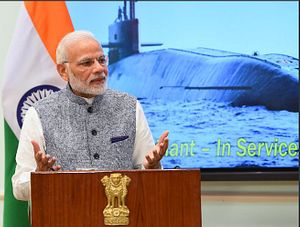On Sunday, India conducted a test launch of the K-4 intermediate-range submarine-launched ballistic missile (SLBM). The test was overseen by the Defense Research and Development Organization (DRDO), the Indian agency tasked with developing indigenous weapons systems.
The test took place in the Bay of Bengal, off the coast of the Indian state of Andhra Pradesh, near Vizag. The test took place between noon and 1 p.m. local time on Sunday, according to Indian reports.
A nuclear-capable missile, the K-4 will eventually arm India’s fleet of nuclear-propelled ballistic missile submarines. Currently, a single Indian ballistic missile submarine, INS Arihant, is operational. The K-4 is reported to have a range capability of around 3,500 kilometers.
Sunday’s test was not conducted off a submarine, but off a submerged pontoon, which is designed to simulate the launch conditions of a submarine without risking an actual submarine in case of a catastrophic launch failure.
One anonymous Indian official who spoke to The Hindu emphasized the K-4’s precision. “Our Circular Error Probability (CEP) is much more sophisticated than Chinese missiles,” the official said. CEP defines the radius of a circle within which 50 percent of all shots of a given projectile are expected to land.
The K-4 has been in developmental testing since 2010. Initial testing focused on undersea ejection. The solid-propellant missile was derived from India’s land-based Agni series of missiles.
Apart from the K-4, India has developed the K-15 Sagarika short-range submarine-launched ballistic missile. Also nuclear capable, the Sagarika has an estimated range capability of 700 kilometers. The Sagarika is primarily positioned to hold targets in southern Pakistan, including Karachi, at risk from the Sea.
The shorter-range K-15, moreover, does not possess a capability to hold at risk any significant targets in China from the Indian Ocean. The K-4 is designed to eventually serve as the mainstay in India’s growing ballistic missile submarine force.
INS Arihant, India’s sole operational ballistic missile submarine, is capable of accommodating either four of the large K-4 missiles in its launch tubes, or alternatively, 12 K-15s.
India’s first ballistic missile submarine was commissioned into the Indian Navy in 2016. In November 2018, Indian Prime Minister Narendra Modi confirmed that INS Arihant had conducted its first deterrent patrol.
Alongside India, both China and Pakistan are invested in sea-based nuclear forces. China is currently on its second generation of ballistic missile submarines, which are equipped with the JL-2 submarine-launched ballistic missile. Beijing is developing the JL-3, a longer-range submarine-launched ballistic missile.
Pakistan, meanwhile, has been developing the Babur-3 submarine-launched cruise missile, which will eventually arm its three Agosta 90B attack submarines. The Babur-3, when deployed, will be Pakistan’s first sea-based nuclear capability.
A second Indian ballistic missile submarine, INS Arighat, is under development.

































